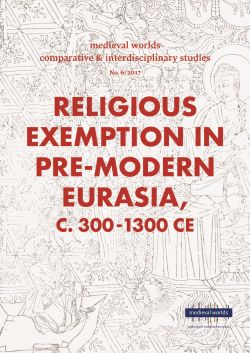Walter POHL – Andre GINGRICH (Eds.)
medieval worlds • no. 6 • 2017
Religious Exemption in Pre-Modern Eurasia, C. 300-1300 CE
Mario Poceski
S. 40 - 60
doi:
10.1553/medievalworlds_no6_2017s40
Verlag der Österreichischen Akademie der Wissenschaften
Abstract:
The article explores central aspects of the relationship between the Buddhist monastic order and the various imperial states that ruled China during the medieval period (roughly between the third and the tenth centuries CE). It focuses especially on the points of tension created by the monastic order’s efforts to establish a sense of autonomy and receive special economic, political, or social exemptions on one hand, and the royal imperium’s assertion of absolute authority over all subjects on the other hand. While the monastic order’s efforts to safeguard its independence and ward off the encroachment of a totalitarian state was largely a losing proposition, in a protracted process that involved complex socio-political negotiations and shifting religious realignments, the Buddhist clergy was able to secure important exemptions from the Chinese rulers’ demands. Most notably, these included exemptions from certain forms of taxation, military conscription, and forced labour, which helped secure the economic foundations of monastic life and enhance the prominent place of Buddhism in Chinese society. To illustrate these issues, the article explores some of the key debates that pitted prominent Buddhist monastics such as Huiyuan (334-416) against key segments of the Chinese socio-political elites, many of whom were influenced by a Confucian ideology that was often inimical to monastic institutions.
medieval China; Buddhism; Huiyuan; monastic order
Published Online:
2017/12/01 11:39:50
Object Identifier:
0xc1aa5576 0x00372f1b
Rights:All rights reserved.For questions regarding copyright and copies please contact us by email.
MEDIEVAL WORLDS provides a new forum for interdisciplinary and transcultural studies of the Middle Ages. Specifically it encourages and links comparative research between different regions and fields and promotes methodological innovation in transdisciplinary studies. Focusing on the Middle Ages (c. 400-1500 CE, but can be extended whenever thematically fruitful or appropriate), MEDIEVAL WORLDS takes a global approach to studying history in a comparative setting.
MEDIEVAL WORLDS is open to regular submissions on comparative topics, but also offers the possibility to propose or advertise subjects that lend themselves to comparison. With a view to connecting people working on related topics in different academic environments, we publish calls for matching articles and for contributions on particular issues.
Table of Contents
Religious Exemption in Pre-Modern Eurasia, c. 300 – 1300 CE: Introduction
Charles West
Treasures in Heaven: Defining the Eurasian Old Regime?
R. I. Moore
Envisioning a No-Man’s Land: Hermitage as a Site of Exemption in Ancient and Early Medieval
Indian Literature
Kanad Sinha
Evolving Relationship between the Buddhist Monastic Order and the Imperial States of Medieval
China
Mario Poceski
The Normative Character of Monastic Exemption in the Early Medieval Latin West
Kriston R. Rennie
Clerical Exemption in Canon Law from Gratian to the Decretals
Anne J. Duggan
Nothing to Declare: Status, Power and Religious Aspiration in the Policies of Taxation in Ancient
India
Ulrich Pagel
Exemption Not Granted: The Confrontation between Buddhism and the Chinese State in Late
Antiquity and the ‘First Great Divergence’ Between China and Western Eurasia
Antonello Palumbo
The Political Significance of Gifts of Power in the Khmer and Mercian Kingdoms 793-926
Dominic Goodall and Andrew Wareham
Conversion, Exemption, and Manipulation: Social Benefits and Conversion to Islam in Late Antiquity
and the Middle Ages
Uriel Simonsohn
Religious Exemption, Justice, and Territories around the Year 1000: The Forgeries of Worms
Thomas Kohl
The Exemption that Proves the Rule: Autonomy and Authority between Alcuin, Theodulf and
Charlemagne (802)
Rutger Kramer
From Symbiosis to Separate Spheres? England, 1163
Judith A. Green
Religious Exemption and Global History before 1300 – Closing Comments
Julia McClure




 Home
Home Print
Print
 References
References
 Share
Share
